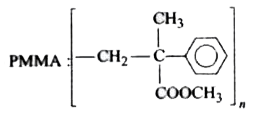Which of the following is not correctly match the final major product?
CH3CH=CH2HO−Cl−−−−→CH3−OH∣CH−C∣ClH2

Cl−CH=CH2HCl−−→H2O2Cl−Cl∣CH−CH3
All of these
The correct Answer is:B
To solve the question "Which of the following is not correctly matched with the final major product?", we will analyze each option provided, focusing on the reactions and their expected products.
1. Identify the Reactions:
We need to analyze the reactions given in each option to determine the products formed. The question states that we are looking for the one that does not match the expected product.
2. First Reaction:
- Reactants: Alkene + HOCl
- Mechanism: This is an electrophilic addition reaction where Cl+ acts as the electrophile and OH- acts as the nucleophile.
- Product Formation: The electrophile (Cl+) attacks the terminal carbon of the alkene, forming a secondary carbocation. The nucleophile (OH-) then attacks the carbocation.
- Expected Product: The product formed is CH3CH(OH)CH2Cl, which is correctly matched.
3. Second Reaction:
- Reactants: Alkene + ICl
- Mechanism: Similar to the first reaction, this is also an electrophilic addition reaction. I+ is the electrophile and Cl- is the nucleophile.
- Product Formation: The electrophile (I+) attacks the carbon to form a tertiary carbocation. The nucleophile (Cl-) then attacks this carbocation.
- Expected Product: The correct product should be CH3C(I)ClCH2, where I is attached to the more substituted carbon, not to the methyl group.
- Incorrect Match: If the product shows I attached to the methyl group, this is incorrect.
4. Third Reaction:
- Reactants: Alkene + HCl
- Mechanism: This reaction follows the anti-Markovnikov rule, where Cl- will attack the carbon with fewer hydrogen atoms.
- Product Formation: The Cl- will attach to the less substituted carbon, leading to the formation of a dichloro compound.
- Expected Product: The product formed is correctly matched.
5. Conclusion:
Based on the analysis, the second reaction is the one that does not correctly match the final major product. The expected product for the second reaction is not correctly represented in the options provided.
Final Answer:
The second option is the one that is not correctly matched with the final major product.
---
We need to analyze the reactions given in each option to determine the products formed. The question states that we are looking for the one that does not match the expected product.
- Reactants: Alkene + HOCl
- Mechanism: This is an electrophilic addition reaction where Cl+ acts as the electrophile and OH- acts as the nucleophile.
- Product Formation: The electrophile (Cl+) attacks the terminal carbon of the alkene, forming a secondary carbocation. The nucleophile (OH-) then attacks the carbocation.
- Expected Product: The product formed is CH3CH(OH)CH2Cl, which is correctly matched.
- Reactants: Alkene + ICl
- Mechanism: Similar to the first reaction, this is also an electrophilic addition reaction. I+ is the electrophile and Cl- is the nucleophile.
- Product Formation: The electrophile (I+) attacks the carbon to form a tertiary carbocation. The nucleophile (Cl-) then attacks this carbocation.
- Expected Product: The correct product should be CH3C(I)ClCH2, where I is attached to the more substituted carbon, not to the methyl group.
- Incorrect Match: If the product shows I attached to the methyl group, this is incorrect.
- Reactants: Alkene + HCl
- Mechanism: This reaction follows the anti-Markovnikov rule, where Cl- will attack the carbon with fewer hydrogen atoms.
- Product Formation: The Cl- will attach to the less substituted carbon, leading to the formation of a dichloro compound.
- Expected Product: The product formed is correctly matched.
Based on the analysis, the second reaction is the one that does not correctly match the final major product. The expected product for the second reaction is not correctly represented in the options provided.
The second option is the one that is not correctly matched with the final major product.
Topper's Solved these Questions
- TEST PAPERSBOOK - ALLENCHAPTER - TEST PAPERSEXERCISE - PAPER 2
58 Videos
- TEST PAPERSBOOK - ALLENCHAPTER - TEST PAPERSEXERCISE - part-2Chemistry
21 Videos
- TEST PAPERSBOOK - ALLENCHAPTER - TEST PAPERSEXERCISE - MATHEMATICS
2 Videos
- TEST PAPER 4BOOK - ALLENCHAPTER - TEST PAPER 4EXERCISE - CHEMISTRY
45 Videos
- THERMODYNAMICS BOOK - ALLENCHAPTER - THERMODYNAMICS EXERCISE - EXERCISE -4
18 Videos
Similar Questions
Knowledge Check
Which of the following is not correctly matched?
ANeoprene: ⎡⎢⎣−CH2−C∣Cl=CH−CH2−⎤⎥⎦nBNylon-66 ⎡⎢⎣−NH−[CH2]6−NH−CO−[CH2]4−O∣∣C−O−⎤⎥⎦nC D
D
Which of the following is not correctly matched ?
ANeoprene : ⎡⎢ ⎢⎣−−CH2−C∣Cl=CH−CH2−−⎤⎥ ⎥⎦nBNylon-6,6 : ⎡⎢ ⎢⎣−−NH(CH2)6−NH−CO(CH2)4−O||C−O−−⎤⎥ ⎥⎦nC DPMMA: ⎡⎢ ⎢⎣−−CH2−CH3∣C∣COOCH3−−⎤⎥ ⎥⎦n
DPMMA: ⎡⎢ ⎢⎣−−CH2−CH3∣C∣COOCH3−−⎤⎥ ⎥⎦n
Which of the following is not correctly matched
View SolutionWhich of the following is not correctly matched
View SolutionWhich of the following is not correctly matched
View SolutionWhich of the following is not correctly matched
View SolutionWhich of the following is not correctly matched :-
View SolutionWhich of the following is not correctly matched:
View Solution
